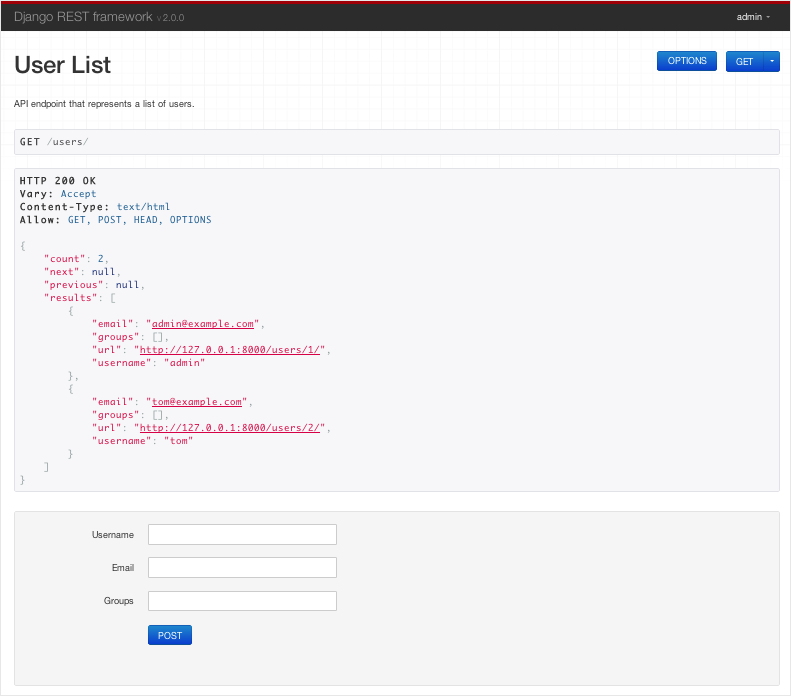Quickstart
译于官方Quickstart
我们在这里实现一个简单的API,为admin用户创建一个user和groups的编辑界面。
Project setup
创建一个名为 tutorial的Django项目,然后创建一个app命名为 quickstart
# Create the project directory mkdir tutorial cd tutorial # Create a virtualenv to isolate our package dependencies locally virtualenv env source env/bin/activate # On Windows use `env\Scripts\activate` # Install Django and Django REST framework into the virtualenv pip install django pip install djangorestframework # Set up a new project with a single application django-admin.py startproject tutorial . # Note the trailing '.' character cd tutorial django-admin.py startapp quickstart cd ..
首先需要同步你的数据库
python manage.py migrate
然后创建一个管理员用户名为 admin ,在此将密码设为 password123。本例中将用这个账号进行认证登录。
python manage.py createsuperuser
创建完数据库和管理用户之后,接下来我们可以打开app目录,正式开始编程之旅…
Serializers
首先我们要定义几个serializers。 在项目目录下创建一个新的模块命名为 tutorial/quickstart/serializers.py ,我们将通过它来展示数据。
from django.contrib.auth.models import User, Group
from rest_framework import serializers
class UserSerializer(serializers.HyperlinkedModelSerializer):
class Meta:
model = User
fields = ('url', 'username', 'email', 'groups')
class GroupSerializer(serializers.HyperlinkedModelSerializer):
class Meta:
model = Group
fields = ('url', 'name')
请注意,我们在这里通过 HyperlinkedModelSerializer使用hyperlinking relationships。你可以改变引用来使用其他的relationships,但hyperlinking 是很好的 RESTful 设计。
Views
好的,接下来应该写一些views。请在 tutorial/quickstart/views.py 中键入以下内容。
from django.contrib.auth.models import User, Group
from rest_framework import viewsets
from tutorial.quickstart.serializers import UserSerializer, GroupSerializer
class UserViewSet(viewsets.ModelViewSet):
"""
API endpoint that allows users to be viewed or edited.
"""
queryset = User.objects.all().order_by('-date_joined')
serializer_class = UserSerializer
class GroupViewSet(viewsets.ModelViewSet):
"""
API endpoint that allows groups to be viewed or edited.
"""
queryset = Group.objects.all()
serializer_class = GroupSerializer
比起写多个view的做法,我们将所有的常用的behavior都写入一个类 ViewSets。当然,如果有需要也可以很容易的将其分割为多个view,但是使用viewsets能够使应用的逻辑更简洁易于管理。
URLs
下面该写API URLs ,其位于 tutorial/urls.py
from django.conf.urls import url, include
from rest_framework import routers
from tutorial.quickstart import views
router = routers.DefaultRouter()
router.register(r'users', views.UserViewSet)
router.register(r'groups', views.GroupViewSet)
# Wire up our API using automatic URL routing.
# Additionally, we include login URLs for the browsable API.
urlpatterns = [
url(r'^', include(router.urls)),
url(r'^api-auth/', include('rest_framework.urls', namespace='rest_framework'))
]
由于我我们在这里使用的viewsets 代替了 views,我们可以自动生成API的URL conf ,你只需要将viewsets注册到router即可。
另外,如果我们需要对API URLs进行更多的控制,那么可以使用原有的views方式,然后把 URL conf写清楚。
最后,通过可视化API,我们默认使用了login和logout的视图。 这个功能是可选的,不过当你需要可视化API或者你的API需要认证时,它将很有用。
Settings
我们还要进行一个全局设定,我们要开启分页功能,并且希望API只能被admin用户访问。进行这些设定的模块为 tutorial/settings.py
INSTALLED_APPS = (
...
'rest_framework',
)
REST_FRAMEWORK = {
'DEFAULT_PERMISSION_CLASSES': ('rest_framework.permissions.IsAdminUser',),
'PAGE_SIZE': 10
}
Okay, we’re done.
测试我们的API
现在我们准备好测试刚刚创建的API,先通过命令行运行项目。
python ./manage.py runserver
可以用命令行或者curl之类的工具来访问API
bash: curl -H 'Accept: application/json; indent=4' -u admin:password123 http://127.0.0.1:8000/users/
{
"count": 2,
"next": null,
"previous": null,
"results": [
{
"email": "admin@example.com",
"groups": [],
"url": "http://127.0.0.1:8000/users/1/",
"username": "admin"
},
{
"email": "tom@example.com",
"groups": [ ],
"url": "http://127.0.0.1:8000/users/2/",
"username": "tom"
}
]
}
或者使用httpie,一个命令行工具
bash: http -a admin:password123 http://127.0.0.1:8000/users/
HTTP/1.1 200 OK
...
{
"count": 2,
"next": null,
"previous": null,
"results": [
{
"email": "admin@example.com",
"groups": [],
"url": "http://localhost:8000/users/1/",
"username": "paul"
},
{
"email": "tom@example.com",
"groups": [ ],
"url": "http://127.0.0.1:8000/users/2/",
"username": "tom"
}
]
}
当然也可以直接用浏览器

If you’re working through the browser, make sure to login using the control in the top right corner. Great, that was easy! If you want to get a more in depth understanding of how REST framework fits together head on over to the tutorial, or start browsing the API guide.